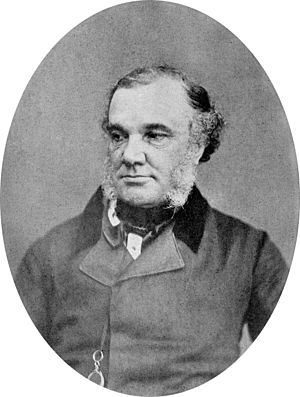Thomas Addison facts for kids
Quick facts for kids
Thomas J Addison
|
|
|---|---|
 |
|
| Born | April 1793 Longbenton, Northumberland, England
|
| Died | 29 June 1860 (aged 67) |
| Resting place | Lanercost Priory |
| Alma mater | University of Edinburgh |
| Occupation | Physician |
| Known for | Addison's Disease, Pernicious anemia |
| Signature | |
 |
|
Thomas J Addison (April 1793 – 29 June 1860) was a famous English doctor and scientist. He is known as one of the "great men" of Guy's Hospital in London.
Dr. Addison discovered several important diseases. These include Addison's disease, which affects the adrenal glands, and a blood problem called pernicious anemia. This anemia was later found to be caused by the body not absorbing enough vitamin B12.
Contents
Early Life and Education
Thomas Addison was born in April 1793 in Longbenton, near Newcastle upon Tyne, England. His exact birth date is not known. His father, Joseph Addison, was a grocer and flour dealer.
Thomas went to the local Thomas Rutter school. Later, he attended the Royal Free Grammar School in Newcastle upon Tyne. He learned Latin very well and could even speak it fluently.
His father wanted him to become a lawyer. However, Thomas chose a different path. In 1812, he started studying medicine at the University of Edinburgh Medical School. He joined the Royal Medical Society, which is still active today. In 1815, he earned his degree as a doctor of medicine.
After finishing his studies, Addison moved to London. He became a house surgeon (a doctor in training) at the Lock Hospital. He also learned from another doctor, Thomas Bateman. Addison soon started his own medical practice.
He became very interested in skin diseases, also known as dermatology. This interest lasted his whole life. It led him to be the first to describe the skin changes seen in what is now called Addison's disease.
Working at Guy's Hospital
Thomas Addison's important career at Guy's Hospital began in 1817. He joined as a medical student. Records show he paid a fee to be a "perpetual Physician's pupil." In 1819, he became a licensed doctor with the Royal College of Physicians. Later, he was elected a fellow of the Royal College.
Addison was promoted to assistant physician in 1824. In 1827, he started teaching about medicines. By 1835, he was teaching practical medicine with Richard Bright. In 1837, he became a full physician at Guy's Hospital. When Bright retired in 1840, Addison became the main lecturer. He taught until about 1854–55.
Addison was a brilliant teacher. He attracted many medical students to his lectures. He was also excellent at diagnosing illnesses. He was a quiet person and did not have a very large private practice. However, he was one of the most respected doctors at Guy's Hospital. He spent most of his time helping his students and patients.
Later Years and Legacy
Thomas Addison faced health challenges later in his life. These health issues led him to retire in 1860. He wrote to his medical students, explaining that his health had broken down. He said he could no longer handle the stress of his job.
He passed away on June 29, 1860, at the age of 67. He was buried in the churchyard of Lanercost Priory in Cumbria. Guy's Hospital honored him by making a statue of him. They also named a hall after him and placed a special plaque in the hospital chapel.
Diseases Named After Addison
Thomas Addison is famous for describing many different diseases. His name is part of several medical conditions:
- Addison's disease: This condition is sometimes called bronze skin disease. It happens when the adrenal glands are slowly destroyed. This leads to a lack of important hormones. Addison described this in his 1855 book.
- Addisonian crisis (or Addison's crisis): This is a very serious, life-threatening emergency caused by Addison's disease.
- Addisonism: This describes symptoms that look like Addison's disease. However, they are not caused by a problem with the adrenal glands.
- Addisonian anemia or Addison-Biermer disease: This is now known as pernicious anemia. It is caused by a lack of vitamin B12. Addison first described this in 1849.
- Addison-Schilder syndrome: This is a metabolic disorder. It combines features of Addison's disease (bronze skin) with a brain condition called cerebral sclerosis. It is also known as adrenoleukodystrophy.
Addison also gave one of the first good descriptions of appendicitis in 1829. He also wrote an important study about how poisons affect the body. He helped us understand many other diseases, including:
- Alibert's disease I: A skin disease with pinkish patches surrounded by a purplish border.
- Allgrove's syndrome: A problem present from birth that affects tear production.
- Rayer's disease: A disorder with light patches on the skin, yellow skin (jaundice), and an enlarged liver and spleen.
See also
 In Spanish: Thomas Addison para niños
In Spanish: Thomas Addison para niños


